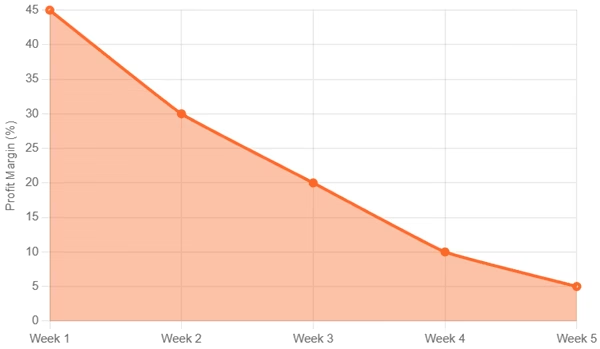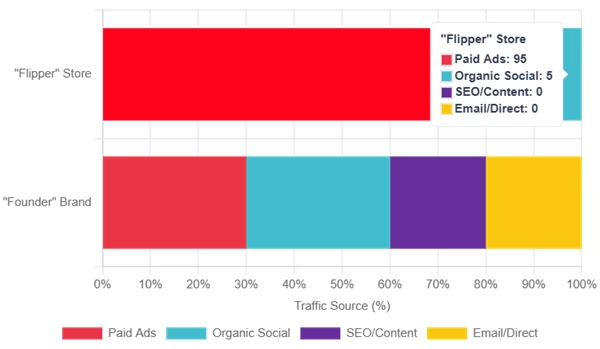
Short Answer: Yes, dropshipping remains highly profitable in 2025; however, the methods that were successful in 2018 are now a guaranteed way to fail. The model hasn’t died; it has matured.
Key Stat: This isn’t just a small-time trend; it’s a massive, growing industry. According to a report by Grand View Research, the global dropshipping market is projected to reach an estimated $464.44 billion in 2025. This proves the model is not only viable but thriving.
For beginners, dropshipping is a retail business model where you sell products online without holding physical inventory. In this business method, the supplier ships items directly to your customers after you make a sale on your online store. Dropshipping is ideal for anyone looking to run an ecommerce site with a small capital.
This article will give you the “honest truth” about the new challenges and provide a clear, actionable 5-step strategy for “what to do” to succeed in 2026.
The “Hard Truth”: Why 90% of New Dropshipping Stores Fail in 2025
Let’s see the challenges head-on to build trust. It’s not “dead,” but it is harder.
Challenge 1: Sky-High Ad Costs & The End of “Easy” Traffic
TikTok is a good platform for dropshipping businesses. But the “TikTok ad gold rush” of the early 2020s is over. The platform is now a mature, competitive ad space, and costs have risen to match.
On the other hand, both Meta (Facebook/Instagram) and TikTok are facing intense competition from advertisers. This drives up Customer Acquisition Costs (CAC) significantly. One 2025 report noted Facebook’s average cost per lead (CPL) jumped 21% year-over-year.
When your entire business model relies on low-margin products, a high CAC is a death sentence. If it costs you $30 in ads to sell a product that only makes you $25, you’re paying to go out of business.
So, relying 100% on paid ads is no longer a business model; it’s a gamble. Without a way to get “free” traffic (like SEO or organic social) or increase your Customer Lifetime Value (LTV), you cannot build a sustainable dropshipping business.
Challenge 2: Shipping & Supplier Nightmares
Customers usually expect free 2-3 day shipping, period. The days of patiently waiting 20-30 days for an ePacket from China are over. A long shipping time is the #1 reason for cart abandonment.
Think. As of 2025, new trade policies and tariffs on goods from traditional manufacturing hubs like China have become a major financial blow. The elimination of the $800 de minimis exemption (which once allowed most dropshipping packages to enter the U.S. tax-free) means unpredictable and costly duties are now applied, wiping out already thin margins.
As a dropshipper, you are 100% reliant on a supplier you’ve never met. When they ship a defective item, a bad variation, or a product that looks nothing like your ad, you are the one who gets the angry email. This leads directly to negative reviews, public complaints on social media, and a surge in credit card chargebacks, which can get your payment processors (like Stripe or Shopify Payments) to freeze your funds or shut you down permanently.
Challenge 3: The Sea of “Me Too” Stores
Because of its easy startup model, there are a lot of similar businesses, and competition is at an all-time high. Product research tools show everyone in the same list of “viral products,” leading to thousands of stores launching at the same time, all selling the same item.
You know today’s online shoppers are intelligent. They can instantly spot a generic, low-effort store. This includes: the default Shopify theme of your store, stolen, low-quality TikTok ad videos, AI-written product descriptions that are full of nonsense, no “About Us” page, no contact info, no real brand story, and prices that are “too good to be true.”
When a product goes viral, it’s a race to the bottom. Everyone copies the ads and finds the same supplier. To get sales, new stores drop their price by $1. Then the next store drops it by another $1. Within weeks, the profit margin is gone, and everyone moves on to the next “winning product,” leaving a trail of failed stores and unhappy customers.
Challenge 4: Stricter Platform Rules
We have to remember the rules of the platforms we use. They are protecting their own reputation and bottom line. For example, Shopify doesn’t want its brand associated with scams. Payment processors like Stripe and PayPal lose money on every chargeback and risk their relationships with Visa and Mastercard.
If your store is new and seen as “high-risk” (which most dropshippers are), payment processors will place a “rolling reserve” on your account. This means they’ll hold 5-10% of your revenue for 90 or even 180 days to cover future disputes, destroying your cash flow. Most processors will permanently ban your account if your chargeback rate (the percentage of orders that are disputed) goes over 0.75% to 1%. For a dropshipper with supplier issues, this is incredibly easy to hit.
It’s not just payment processors. Shopify itself will shut down stores with high complaint rates. Meta (Facebook) will ban ad accounts with “Poor” customer feedback scores, cutting off your traffic source overnight due to slow shipping or bad product quality.
What to Do: The 5-Step Playbook for a Profitable 2026 Dropshipping Business
Now, let’s discuss the “What to Do” part. Think of these as the solutions to the dropshipping business challenges above. Beginners or even those who have been struggling for a long time need to follow these steps:
Step 1: Build a Brand, Not Just a Store
The Problem it Solves: The “Me Too” competition and low customer trust.
What Should You Do?
1. Research for a good niche and sub-niche
Don’t be a “general store” that sells many product types like dog toys, kitchen gadgets, and phone cases. You can’t compete with Amazon or Temu. Instead, become the go-to expert for a specific audience. For example, “Eco-friendly dog toys” can be a good niche. However, look for a better niche like “Eco-friendly, durable toys for power-chewing dogs.” This focus allows you to build a real audience, charge premium prices, and create content that actually resonates.
2. Create a Real Brand Identity
A brand is a feeling. It’s the reason a customer trusts you. Here’s what you should do:
- Your Unique Logo & Visuals: Get a clean, professional logo. Use a consistent color palette (2-3 colors) and fonts throughout your site and social media channels.
- Your Website: Invest in a premium Shopify theme (or spend time customizing a free one). It’s the #1 trust signal.
- Include a Real “About Us” Page: Tell your story on the page. Why did you start this store? Do you love dogs? Are you passionate about minimalism? This one page can be the difference between a sale and a bounce.
- Develop a Unique Brand Voice: Avoid using the supplier’s robotic, AI-generated descriptions. Rewrite them in your own voice—be funny, be professional, be helpful.
3. Implement Branded Dropshipping
This is the key to making customers feel like they bought from a real brand, not a middleman. Consider working with suppliers (like Zendrop, CJ Dropshipping, or various Print-on-Demand services) who will ship products with your branding. This can include a custom logo on the product, branded packaging (boxes/mailers), thank-you card inserts with your logo, or a custom shipping label.
If you do so, it will create a professional unboxing experience, justify a higher price, and encourage repeat business and social media sharing.
Step 2: Win with Logistics (Fast, Local, & Transparent Shipping)
The Problem it Solves: The “Amazon Effect” (Challenge 2), crushing tariffs, and high chargeback rates.
What Should You Do?
1. Prioritize Local Suppliers: This is non-negotiable in 2025 or 2026. Look for suppliers with warehouses in your target sales country (e.g., USA, UK, Germany). This single step solves three problems:
- Shipping Speed: It allows you to offer 3-7 day shipping, which meets modern customer expectations.
- Tariff Avoidance: The product is already in the country, so it bypasses the new, costly import tariffs and customs delays on individual packages.
- Higher Quality: Local suppliers are often vetted more thoroughly and offer better, more consistent product quality.
2. Know Your Supplier Platforms: Don’t stop at AliExpress as your primary supplier. Expand your product research to other platforms. Platforms like CJ Dropshipping and Zendrop are built for a hybrid model. They have warehouses in both China and the US, allowing you to test a product from China but then stock it in a US warehouse once it’s a proven seller.
Platforms like Spocket or Syncee focus almost exclusively on high-quality US and EU suppliers. The product cost is higher, but this is easily covered by the premium price your brand (see Step 1) can charge.
Use Print-on-Demand (POD). Services like Printful or Printify are the original local dropshipping. Since every item (t-shirts, mugs, posters) is printed and shipped from a local facility, you never have to worry about China-based shipping.
3. Master the Art of Transparency (The “Honesty Policy”): Don’t lie about shipping. If you absolutely must use a supplier with a 10-15 day shipping time for a unique product, state it clearly and repeatedly—on your product page, in your shipping policy, and on the checkout page.
This is important because a customer who is told “Please allow 10-15 days for delivery” before they buy is informed. A customer who is promised 5-day shipping and is still waiting on day 15 is an angry customer who will file a chargeback. Transparency builds trust and prevents disputes that get your store shut down.
Step 3: Diversify Your Traffic (Beyond Paid Ads)
The Problem it Solves: Sky-high ad costs and total reliance on platforms you don’t control.
What Should You Do?
1. Master Organic Short-Form Video (TikTok/Reels/Shorts): Stop selling, start entertaining. Don’t just post ads. Create content that provides value within your niche.
Brainstorm content ideas. It can be a common problem in your niche, and show how your product solves it. Stitch or repost videos from happy customers (User-Generated Content). This is the most powerful social proof.
You can also create educational content like “5 Ways to [Do Task in Your Niche],” “3 Myths About [Your Niche] Busted.” Or you can even show your product-testing process or brand story.
The goal is to build a community of fans, not just a list of customers. The “link in bio” becomes a trusted resource, not a spammy sales pitch.
2. Build a Long-Term Asset with SEO & Content Marketing: Publish blog posts. A blog post you write today can bring in free, high-intent traffic for years. It’s an asset that appreciates over time, unlike an ad that stops the moment you stop paying. Start a blog on your Shopify store and answer your customers’ questions. You can write about:
- “How to Choose the Best [Your Product] for [Specific Need]”
- “[Product] vs. [Competitor Product]: An Honest Review”
- “The Ultimate 2025 Guide to [Your Niche Topic]”
When you write blog posts, keep SEO in mind. Use keywords in your blog titles, product descriptions, and collection page descriptions to help Google understand what you sell.
3. Build Your “Owned Audience” with Email Marketing: Use email marketing strategies. If you use TikTok, your following is a “rented” audience—the algorithm decides if they see your content. Build an email list. Your email list is an “owned” audience. You can contact them directly, for free, anytime.
To build your email list, offer an irresistible incentive for signing up. For example, you can use a “10% Off” pop-up. You can run a “Get Our Free 5-Day [Niche Topic] Email Course,” offer “Download Our Free Guide to [Solving a Problem],” or “Get Early Access to New Product Drops.”
To keep your audience happy, don’t just send sales. Use an 80/20 rule: 80% value (helpful tips, brand stories) and 20% sales (promotions, new arrivals). This builds massive Customer Lifetime Value (LTV), which is the true key to profitability.
Step 4: Focus on Sustainability & Value-Based Selling
The Problem it Solves: Competing on price and the “Me Too” store problem.
What Should You Do?
1. Stop Competing on Price, Start Competing on Values: The race to the bottom is unwinnable. Instead, build a brand that stands for something. The “eco-friendly” or “sustainable” trend is no longer a small niche; it’s a massive market driver.
Consumers will pay more for brands that align with their values. Studies from 2025 show that 55% of consumers are willing to pay more for eco-friendly brands, and 59% of Millennials have intentionally chosen products with eco-friendly packaging in the last six months.
2. What to Sell: Look for suppliers offering products like:
- Reusable/zero-waste items (bamboo utensils, reusable bags, compostable kitchenware).
- Organic or non-toxic goods (organic cotton apparel, non-toxic pet toys, natural skincare).
- Products made from recycled materials.
3. How to Find These Suppliers: Use supplier marketplaces with built-in filters for “eco-friendly,” “sustainable,” or “organic” products (e.g., Spocket, Syncee). Look for niche suppliers who are mission-driven themselves (e.g., Jungle Culture for sustainable housewares). You can also check suppliers for credible certifications like Fair Trade, GOTS (for organic textiles), or B Corp status.
4. How to Market It: This becomes the core of your brand (Step 1). Your “About Us” page tells this story. Your social media (Step 3) shows your commitment. You aren’t just selling a product; you’re offering customers a way to make a positive choice. This builds a “moat” that cheap competitors simply cannot cross.
Step 5: Leverage AI & Automation
The Problem it Solves: Being overwhelmed by manual tasks, scaling customer support, and creating content efficiently.
What Should You Do?
Artificial intelligence (AI) is powerful today. You can use it for productivity and automation in your dropshipping business.
1. Don’t use AI to find winning products. Use it for analysis. AI-powered tools (like Tradelle or Minea) can analyze market saturation, spot rising trends on social media before they peak, and identify audience gaps that your niche brand can fill.
2. Automate Customer Service: This is critical for preventing chargebacks (Challenge 4). Implement AI-powered chatbots (like Tidio or Shopify Inbox) on your store. Train it to instantly answer the top 3 questions like “Where is my order (WISMO)?”, “What is your shipping policy?”, and “How do I start a return?”
This provides 24/7 support, reduces customer anxiety, and frees up your time to handle complex problems that actually require a human.
3. Supercharge Content Creation: Use AI as your creative partner, not your final writer. You can feed the generic supplier description into an AI and ask it to rewrite it in your brand’s voice (Step 1), focusing on benefits rather than just features. Use it to generate blog post ideas and a detailed outline for each. You write the final article, ensuring it has a human touch and real expertise.
You can also use AI to write short, punchy scripts for TikTok videos (e.g., “A ‘Problem-Solution’ video for [your product]”). This beats staring at a blank screen and helps you create content faster (Step 3).
But always remember the rule! AI generates the first draft. You provide the final polish, brand voice, and human connection.
Final Verdict: So, Is Dropshipping Profitable in 2025 or 2026?
My honest answer is YES. Dropshipping is still absolutely profitable in 2025 and will continue to be so in 2026, but don’t think it is a “get rich quick” scheme. It has evolved into a “get rich right” model. The days of low-effort, copy-and-paste stores are definitely over, and they’ve been replaced by a new, more sustainable approach.
Now, there is a great shift from “Flippers” to “Founders”. The profits have permanently shifted away from anonymous “product-flippers” who compete on price and instead flow to thoughtful “brand-founders” who compete on value. The old way is dead – relying on spy tools, 30-day AliExpress shipping, and running Facebook ads to a generic store.
What you should do now is to build a real brand in a defined niche, leverage local suppliers for fast shipping, and create an “owned” audience through organic content and email marketing.
Now it is clear that the dropshipping market is growing, not shrinking. The only question is how you’ll adapt. Stop looking for the next “winning product” and start building a real, long-term brand. The 5-step playbook in this article isn’t just a suggestion—it’s the new minimum requirement for success. The opportunity is massive, but it’s waiting for entrepreneurs, not gamblers.
Learn more about dropshipping market and trends at Grand View Research.
Dropshipping Guides, Services, and Tools
If you want to succeed, never stop learning. Numerous guides, expert services, and tools are available to help you achieve your goals. Both novice and experienced dropshippers should utilize these resources to enhance their knowledge.
- Best dropshipping books
- Udemy dropshipping courses
- Dropshipping services (Fiverr)
- Ecommerce business tools (lifetime deals)
Written and edited by: Ibochouba Singh
Dated: November 7, 2025
Disclosure: We are partners or associates of Amazon and other top brands. We may earn a small amount from qualifying purchases without increasing the price. Please read our full affiliate disclosure here.
Ibochouba Singh is a content writer and reviewer with a passion for writing about digital marketing and tech gadgets, including software tools and new tech gadgets. He has over 15 years of experience writing for several consumers and clients, including tech startups, marketing agencies, and software companies. He has written many articles and product reviews for many websites, including nigcworld.com and buywin.in.





